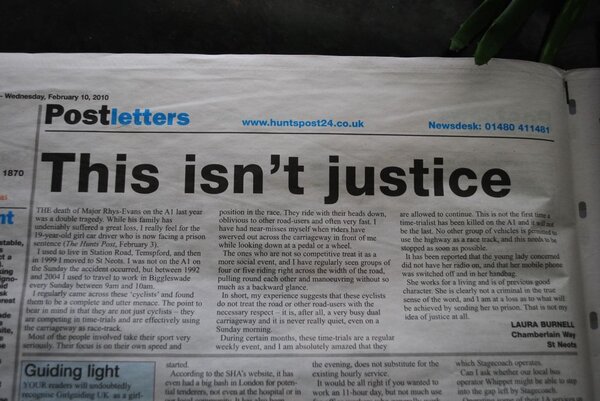her letter was a bit pointless as where the main part of the TT takes place has 50 and 60mph speed limits and two wide lanes. The way her letter scans is that there is never anywhere to overtake and that they shouldnt be allowed.
The whole point of time trailling is that racing was banned and that they are spread out to avoid bunching.
I do not like the rather selfish attitude of the lady's letter regarding other road users. Perhaps the lady should re-aquaint herself with the Highway Code. It is legal for a cyclist to ride on a dual carriage way but not a motorway.
I feel that her attitude to other road users is the typical selfish view held by many drivers and publishing her letter in no way helps improve matters regarding such tragic events. There are rules for cyclists and rules for the car driver - the car driver MUST be made to understand that they can cause death an injury by ignoring these rules.
From the highway code:
204
The most vulnerable road users are pedestrians, cyclists, motorcyclists and horse riders. It is particularly important to be aware of children, older and disabled people, and learner and inexperienced drivers and riders.
212
When passing motorcyclists and cyclists, give them plenty of room (see Rules 162-167). If they look over their shoulder it could mean that they intend to pull out, turn right or change direction. Give them time and space to do so.
Time Trial Safety
When time trial courses are designed, safety is a major consideration. However, a competitor’s safety remains entirely his or her own responsibility. Events are held on open roads, and competitors must obey the relevant laws and the Highway Code before, during and after a race. Competitors must avoid creating situations that are unsafe for other road users.
There are a number of other points that will help everyone to enjoy safer racing:
Cyclists are less visible than most other road users. You should remember this when approaching junctions.
To improve visibility from the rear, race numbers are printed on a bright, reflective background. The number must be placed on your shorts from the waistband downwards, and must not be covered by other clothing. Your number cannot be positioned in the middle of your back, as with a runner’s number, because it would then face upwards when you’re in a riding position.
You should avoid doing U-turns in the road, both while warming up for an event, and after you’ve passed the finish. Drivers do not normally expect other road users to make this manoeuvre, which means it can be dangerous. It is CTT policy to eliminate U-turns from courses, and to reduce their use where they cannot be avoided.
You must avoid riding with your head down. Even on a Clearway, cars may stop for a variety of reasons, and the responsibility for avoiding them rests with the rider. In the event of a collision, the fact that the car was contravening the Clearway regulations will not be an excuse. A rider can expect a suspension from competition for any failure to watch where they are going.
Any road junction or roundabout can constitute a hazard in a race. You will often be approaching much faster than drivers expect of a cyclist, which can lead to errors of judgement on their part. Be ready for this. Care is particularly necessary at slip roads joining and leaving dual carriageways and other major roads, due to the long period when a cyclist can be between two lanes of merging traffic or exposed to vehicles leaving the main carriageway at high speed.
